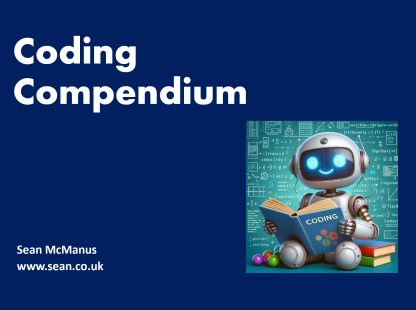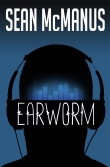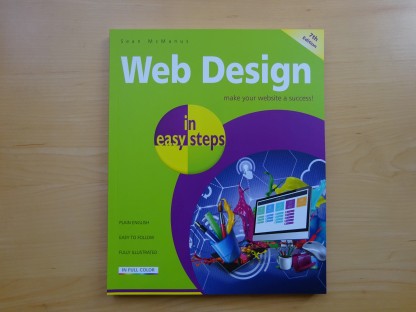
Coding Compendium
A free 100-page ebook collecting my projects and tutorials for Raspberry Pi, micro:bit, Scratch and Python. Simply join my newsletter to download it.
Personal Computer World: May 2000
The future of shopping will put you in control. Products will be made to your specification, as Sean McManus reports.
As the pace of fashion accelerates and product cycles get shorter and shorter, the internet is bringing it to its natural conclusion: customised production of a single item. Just for you.
For a long time mass customisation has been a marketer's dream: the fantasy that machines could be built that automatically tailor products to the customer's requirements. That technology is now here. One limitation was capturing the customer's specification economically. But now that the internet is enabling customers to deliver their specifications in a structured form, everything from books to houses can be tailored online.
"Mass customisation means that the consumer can get only and exactly what he wants, at a price he is willing to pay," says Joe Pine, who together with Jim Gilmore, wrote the book 'Markets of One' about the emerging trend. "When companies mass customise their goods and services, consumers no longer have to sacrifice what they want exactly by buying mass-produced offerings designed for some average, and non-existent, customer," adds Gilmore.
"In some cases the actual product can be customised, such as with information or music, and immediately delivered over the internet. In all cases, information and other representations about the product can be customised to determine which variation the consumer wants," says Gilmore. Many sites create the illusion of customisation, such as the gift advisor at Presentpicker, which just selects mass manufactured gifts in response to customer descriptions of the occasion and the interests of the gift recipient. Alwaysinstyle similarly invites visitors to describe their appearance (eye colour, hair colour) and personality and then advises them which colours best suit them, linking to mass produced products the site considers appropriate. Internet news services might appear to customise their data, but usually only filter a vast stream of data for relevance.
Genuine customisation has been led by an emerging music industry that brings audience-hungry bands together with enthusiasts looking for something new. Do-it-yourself compilation CDs enable customers to create their own playlists from the entire catalogue of songs at sites like Cdiy.com (no longer active as at - August 2002), which promotes new bands. "It attracts gift purchasers, people who don't enjoy record stores and people who feel ripped off by filler tracks on [off-the-shelf] compilations," says Cdiy managing director Denise Proctor. Customers audition tracks on the website and put those they want into their playlist. When the credit card order is confirmed, an email is automatically dispatched to the server which copies the recordings from the hard disc and makes a disc image. A blank CDR is lifted into the burner, burned and then lifted to the printer for the customer's tracklisting and dedication to be printed onto the surface. Another server keeps a track of the royalties owed to performers for each sale of their recording. The only human intervention comes in packaging the CD.
"The benefit is complete personalisation," says Proctor. "The customer will be able to choose from a selection of inlay cards, and to choose a personal message to be printed onto the actual disc along with their unique tracklist. With CDIY, the customer gets to choose exactly which tracks they want, in the order they want." Labels with substantial archives of oldies such as K-Tel are already exploiting similar technology, so that customers who liked one song by The Platters don't have to buy a whole CD of their tracks. In December 1999, sales of Beastie Boys albums rose by 265% at CD Now during a promotion that enabled customers to create their own double CD of 40 tracks from 150 Beastie boys songs.
No book will ever go out of print using this technology
A more sophisticated customisation interface is offered by iPrint.com, a website that sells stationery, mugs, T-shirts, mousepads and more. The site uses a clickable graphics buttons on screen to steer the customer through the options and web forms to gather text and digital images or select combinations of pre-set designs. Designs are tracked using a unique ID and each update is sent back to the server and a new webpage generated, so the site is browser-independent and compatible across a range of platforms. The server-side drawing software enables the webpage to display an impression of what the product will look like, including any uploaded images and customised text and graphics. "The company has taken a traditionally cumbersome, time-consuming and potentially costly process and made it an easy, fast an inexpensive one," claims iPrint.com's public relations associate Eric Atwood. The customer approves the final design and sends it straight for printing, without the human intervention that often causes re-work in traditional printing. Atwood claims the site has an error rate of less than 1% compared to the 10-15% rates traditional printers might encounter. The website technology alone cost over US$1 million to create, excluding the production technology.
The idea of custom printing has even been extended to entire paperback books by Sprout, overcoming the hurdle of the minimum viable print run. Book retailer Borders.com has bought a 20% stake in Sprout and is selling print-on-demand books from its website and through its chain of retail stores. The system costs about £25,000 to licence and occupies sixty square feet of floor space. (As at March 2002, Sprout doesn't appear to be around any more, but similar technology is becoming more widely used. Another company offering a similar service is Lightning Source).
When the Sprout system receives an order, one laser printer works on the black and white pages while another prints the colour cover. An operator transfers the sections into a binder and the book is ready in about fifteen minutes for a three hundred page book. Despite using standard laser printers, Borders spokesman Rich Fahle says that the cover graphics quality is only slightly lower grade than traditionally printed covers. "Moving forward, the technology behind the book purchase will be invisible to the customer," says Fahle. "They'll order a book and won't necessarily have any idea that it was printed on the spot." On-demand books are included alongside mass-printed books in the catalogue.
The guesswork in the publishing industry is removed. Publishers no longer have to estimate print runs, nor must shops guess how many sales they will make. Authors are paid royalties in the same way as with a conventional book. The catalogue already includes thousands of on-demand titles, many of them previously deleted, and some of them exclusive paperback editions of hardback books. "No book will ever go out of print using this technology," says Fahle.
Although not yet being exploited by Borders.com, the technology can be used to personalise the content of a book, for example by dropping a child's name into the story and including photographs as at Kidsinprint (site gone as at March 2003). Combined with automated creative writing technology similar to that developed by Amnesty International (see box below), customers could in future buy books that have been custom written for them. This is most likely to be workable in the children's market, where stories are basic, or in tutorials, where the material could be selected and compiled according to the reader's background and existing knowledge. It will be a long time before computer-generated fiction books can compare with human-authored texts.
Anything you can digitize you can customise. Once it enters the realm of zeroes and ones, you can instantaneously change a zero to a one, and vice versa.
Where goods are carriers for data (books, CDs) or where they are integrated with services (printing), the potential to gather data online is clear. But those aren't the only customisable products. Dell was one of the first to introduce mass customisation on the internet, selling computers through its website since 1996 and now selling more than US$30 million a day. The user orders at www.dell.com, building a machine specification by selecting options in pull-down menus. This data is then routed to the order system and the appropriate manufacturing facility. "There is lots of flexibility," says Dell's global internet PR manager Dave Dix. "They really are made to order. You choose how much memory, how big a hard drive, what size monitor etc." The customers have tended to be 'power users', he says. "Ones who are experienced, savvy and know exactly what they want. It attracts new customers all the time, as the whole world is becoming more and more tech savvy." The machine can be delivered within five days.
Fashion fanatics can already personalise many accessories. Watches can be customised online, giving the buyer the opportunity to choose a face design or email a photograph for the face and to choose the case, strap and hands. This contrasts strongly with Swatch's marketing approach of creating many simultaneous limited editions, so that people rarely encounter others with the same style. Perhaps the only place in the world you can buy fake giraffe-fur flared jeans is Ic3d, where a combination of a web browser and a strong dose of poor taste can enable you to design them.
Nike has launched its Nike iD facility to create limited edition trainers. Customers can choose to customise one of two styles with different bases and material and logo colours and can add an eight letter personal ID that is stitched into the heel of the shoe. Each stage of the selection process updates the on-screen illustration, viewable from several angles. Nike has limited the palette and hand-checks all IDs to ensure that the shoes don't look ugly and to check that offensive IDs, gang related IDs or IDs like 'Reebok' don't end up on their shoes. The shoes, which normally cost around US$80, are sold at a premium of US$10 for the custom design and are delivered within three weeks (so far within the US only).
Customisation is not limited to consumer goods. German housebuilders Streif are using their website to draw up proposals. Customers click through a selection process, choosing the style, size and shape of their house and adding on extra features as appropriate. At the end, they can see a 3D model of the house, complete with furniture and can view automatically generated 2D cross sections. The complete specification is compiled automatically and fed to Streif's marketing team.
"Anything you can digitize you can customise," Gilmore says. "Once it enters the realm of zeroes and ones, you can instantaneously change a zero to a one, and vice versa." In the future, it might be possible to buy tailored software so that people can pick and mix the features they need from today's overbloated applications. One website, Hotbar, already offers visitors the chance to redesign the background they see at the top of their Internet Explorer browser behind the navigation buttons. For Valentine's Day, the site ran a promotion inviting visitors to create e-cards that included one of these 'browser skins'. "What better way to show your love than putting a skin with a photo of that special someone right on your Web browser, where you can see it all day long?" says Hotbar.com president Gabriella Karni. Quite.
Now that the mass customisation technology itself is now becoming a commodity, the industry can only grow. Companies like Gerber Scientific sell the hardware and software used to tailor products including lenses, apparel, signs and packaging. Where Cdiy had to create its technology from scratch, Cdiy is now one of several companies willing to licence its technology to other companies.
So-called 'solid object printers' enable models to be compiled from layers of liquid wax squirted from a group of 352 moving nozzles crossing the printer. The wax is applied in 0.36mm deep layers and dries rapidly. Standard CAD packages are used to render a model, which the printer cuts into layers and then creates in the real world. In future, similar technology could be available in homes and sophisticated web interfaces could enable users to access and tailor design data for products to be 'printed' at home. Already Ticketmaster is challenging accepted notions about the point of delivery for customised products by selling concert tickets in the US for printing on the concertgoer's desktop printer. A bar code included in the ticket file is used to validate the tickets at the venue. Dolls can be customised at Barbie.com with different wigs, skin tones, eye colours and accessories. In future, it might be possible for children to print their own Barbies at home using a more advanced solid object printer.
Everything from temporary tattoos to yachts can now be customised through sites linked at the portal Digichoice (not available as at 15/6/04). As internet commerce catches up with high street retail, customers will be able to demand exactly what they want. And get it. Even Ford, whose founder pioneered homogenous production and offered customers 'any colour you like as long as it's black' is restructuring its company to deliver customised cars. "Most every automobile company over the past six months has announced that they're working on mass customization, so when it hits that industry, the paragon of mass production, you know it's on its way to becoming the predominant mode of production," says Pine.
Human rights organisation Amnesty uses its website (www.appealsww.com) to sell customised protest letters to members. Letters are compiled using randomly chosen snippets of sentence stuck together to create a fresh letter with the same message each time. Facts about the specific case and campaigner details (such as occupation) are blended in where appropriate and the result is sent to the Amnesty member by email as a rich text file. "The probability of two letters coming out the same is virtually nil," says Julian Hall, who wrote the software. "When confronted with six cases in the magazine on which to write letters, many Amnesty members feel overwhelmed," he says. "It gets very difficult to think of original things to say, especially after the second or third letter. The same stock phrases tend to come out time and again. When I developed this system, I found to my surprise that the letters were better than the ones I had been writing myself." As well as having a vast database of synonymous phrases to vary the language, the computer-composed letters avoid repetition and emotive language. The system has built a dictionary of 10,000 synonymous phrases which can be shared across different appeals. New phrases can be added and removed to tie in with particular campaigns.
 Sean McManus's novel Earworm, previously published as University of Death, is a satire of the music industry, based around a major record label and all those who invest their hopes and dreams in it.
Sean McManus's novel Earworm, previously published as University of Death, is a satire of the music industry, based around a major record label and all those who invest their hopes and dreams in it.
The book explores what happens when a major record label comes up with software for mass customising music and uses spyware to sell it to customers, without telling them it's all computer generated. Learn more in this author interview at Frank Piller's mass customisation blog.
"Raising a number of surprisingly sophisticated issues, this book is enjoyably cynical about the seemingly cold-hearted and impenetrable nature of the record industry and peppered with a number of highly comical cameos from the cream of rock'n'roll, which ensures that it never feels like heavy going."
- Record Collector Magazine. More great reviews!
© Sean McManus. All rights reserved.
Visit www.sean.co.uk for free chapters from Sean's coding books (including Mission Python, Scratch Programming in Easy Steps and Coder Academy) and more!

A free 100-page ebook collecting my projects and tutorials for Raspberry Pi, micro:bit, Scratch and Python. Simply join my newsletter to download it.

Web Design in Easy Steps, now in its 7th Edition, shows you how to make effective websites that work on any device.

Power up your Microsoft Excel skills with this powerful pocket-sized book of tips that will save you time and help you learn more from your spreadsheets.

This book, now fully updated for Scratch 3, will take you from the basics of the Scratch language into the depths of its more advanced features. A great way to start programming.

Code a space adventure game in this Python programming book published by No Starch Press.

Discover how to make 3D games, create mazes, build a drum machine, make a game with cartoon animals and more!